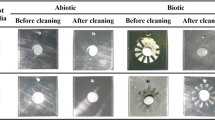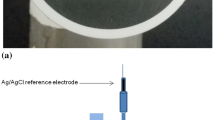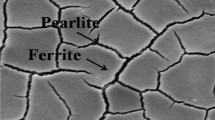Abstract
We study the effect of sulfate reducing bacteria on the electrochemical conditions at the tips of stationary and growing corrosion fatigue cracks in 40Kh steel specimens in Postgate medium. Sulfate-reducing bacteria change significantly the pH and the electrochemical potential at the crack tip and greatly decrease the efficiency of KXO inhibitor. The effect of sulfate-reducing bacteria and KXO inhibitor on the intensity of local anodic dissolution and hydrogen embrittlement in the vicinity of a corrosion fatigue crack tip is estimated.
Similar content being viewed by others
References
E. I. Andreyuk, I. A. Kozlova, Zh. P. Kopteva, et al., “Investigation of microbiological metal corrosion of gas mains and recommendations for rational protection against it,”Ékspress-Inf. VNIIÉgazprom, Gazov. Promyshl., Issue 12, 12–13 (1986).
N. S. Antonovskaya, I. A. Kozlova, and E. I. Andreyuk, “Distribution of sulfate-reducing bacteria in soil near a gas pipeline,”Mikrobiol. Zh., No. 2, 93–94 (1985).
G. A. Sapozhnikov, G. M. Mogil'nitskii, S. A. Eliseenko et al., “Microflora of the ground and soil near Mains in the North, Western Siberia, and the European part of the USSR,” in:Proceedings of an All-Union School-Seminar [in Russian], Naukova Dumka, Kiev (1978), pp. 91–96.
N. S. Antonovskaya, I. A. Kozlova, and E. I. Andreyuk, “Corrosion of low-carbon steel in aDesulfvibrio desulfuricans culture,”Mikrobiol. Zh., No. 1, 13–17 (1985).
N. S. Antonovskaya, A. I. Pilyashenko-Novohatnyi, I. A. Kozlova, and E. I. Andreyuk, “Corrosion of steel in soil under the action of sulfur cycle bacteria,”Mikrobiol. Zh, No. 9, 13–18 (1985).
F. A. Asfandiyarov, I. G. Kil'dibekov, K. R. Nizamov et al., “Special features of the process of corrosion of steel in media containing sulfate-reducing bacteria and hydrogen sulfide,”Korrosiya i Zashchita u Neftegaz. Prom., No. 5, 2–3 (1982).
R. L. Baru, Zh. O. Starosvetskaya, and V. A. Timinin, “The mechanism of biocorrosion of steel in a medium with thionic bacteria,”Zashch. Met. 21, No. 6, 962–965 (1985).
V. V. Panasyuk, L. V. Ratych, and I. N. Dmytrakh, “Determination of the cyclic corrosion resistance of structural materials in a corrosive environment,”Dokl. Akad. Nauk SSSR 269, No. 1, 109–112 (1983).
V. V. Panasyuk, L. V. Ratych, and I. N. Dmytrakh, “A method for determining the electrochemical state at the tip of a crack during testing of structural materials for crack resistance in a corrosive environment,”Zavod. Lab., No. 7. 56–59 (1984).
V. I. Romanenko and S. I. Kuznetsov,Ecology of Microorganisms in Fresh Water [in Russian], Nauka, Moscow (1974).
A. K. Myndyuk, “Inhibitor protection of metals against corrosion,”Fiz.-Khim. Mekh. Mater., No. 1. 84–89 (1985).
A. I. Pilyashenko-Novohatnyi, N. S. Antonovskaya, I. A. Kozlova, et al., “Bactericide properties of corrosion inhibitors of the KXO series with respect to sulfur cycle bacteria,”Microbiol. Zh., No. 6, 88–90 (1985).
L. V. Ratych and I. M. Slobodyan. “Effect of inhibitors on electrochemical conditions during static corrosion crack testing of specimens of 40Kh steel,”Fiz.-Khim. Mekh. Mater., No. 4, 32–37 (1985).
G. Keshe,Metal Corrosion [Russian translation], Metallurgiya, Moscow (1984).
L. V. Ratych and R. A. Barna, “Effect of certain factors on electrochemical conditions at the tip of a corrosion fatigue crack,”Fiz.-Khim. Mekh. Mater., No. 1, 17–26 (1991).
N. P. Zhuk,A Course in the Theory of Corrosion and Protection of Metals [in Russian], Metallurgiya, Moscow (1976).
V. V. Panasyuk, L. V. Ratych, and I. M. Slobodyan, “A method for estimating the efficiency of inhibitor protection of steels against corrosion-mechanical failure,”Fiz.-Khim. Mekh. Mater., No. 3, 3–15 (1986).
J. F. Nott, “Effect of the environment on crack growth under monotonic and cyclic loadings.” in:Fatigue Corrosion of Metals.Proceedings of a USSR — USA Seminar [in Russian], Naukova Dumka, Kiev (1982), pp. 7–38.
V. V. Panasyuk and O. N. Romaniv, “Mechanics of corrosion fatigue decay,” in:Fatigue Corrosion of Metals.Proceedings of a USSR — USA Seminar [in Russian], Naukova Dumka, Kiev (1982), pp. 39–66.
Additional information
Karpenko Physicomechanical Institute, Ukrainian Academy of Sciences, L'viv. Translated from Fiziko-Khimicheskaya Mekhanika Materialov, Vol. 29, No. 5, pp. 72–78, September–October, 1993.
Rights and permissions
About this article
Cite this article
Slobodyan, I.M., Bodak, V.S., Serednyts'kyi, Y.A. et al. Effect of sulfate-reducing bacteria on the electrochemical conditions at a crack tip. Mater Sci 29, 507–513 (1994). https://doi.org/10.1007/BF00558773
Received:
Issue Date:
DOI: https://doi.org/10.1007/BF00558773




